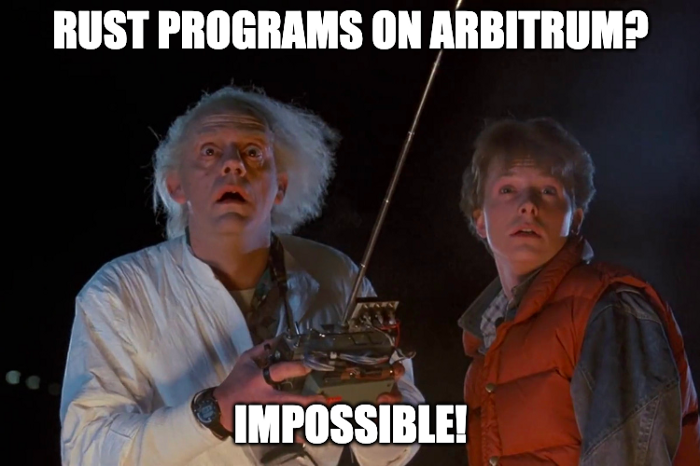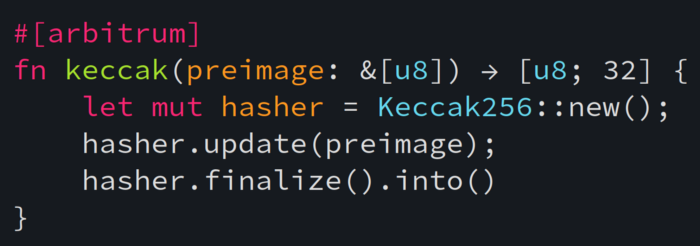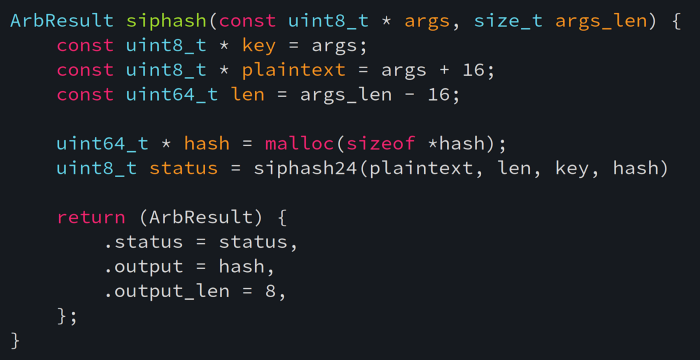解讀Arbitrum大動作:新推出的編程環境Stylus能超越EVM嗎?
來自Medium,原文作者:Offchain Labs
Odaily 譯者| Moni

Odaily 譯者| Moni
來自,原文作者:Offchain Labs2 月7 日,Arbitrum 開發團隊Offchain Labs 宣布將於今年晚些時候為Arbitrum One 和Arbitrum Nova 推出下一代編程環境Stylus,Stylus 通過WebAssembly 智能合約功能,允許開發者使用他們習慣的編程語言(包括Rust、 C 和C++)部署應用程序,以便與Arbitrum 上的EVM 程序一起運行。
二級標題
更重要的是,Offchain Labs 表示Stylus 的速度快了一個數量級,而且可以削減費用且能與以太坊虛擬機完全互操作,甚至將其稱為是
。 Stylus 真的可以超越EVM 嗎?接下來,讓Odaily帶大家一起分析下。
Stylus:超越EVM 等效性

圖片描述
隨著2021 年8 月主網的發布,Arbitrum One 成為唯一具有有效欺詐證明的EVM 等效Rollup,這意味著過去可以在Layer 1 上做的事情,現在都可以在Layer 2 上安全地進行,而且速度更快,費用更低。 EVM 等效性是任何通用Rollup 技術所必需的,也使得Arbitrum One 和Arbitrum Nova 上的去中心化應用程序和協議生態系統更有活力成為可能。
對於使用Stylus 的用戶而言,把那些用流行編程語言編寫的程序——比如Rust、C、C++ 等——部署到Arbitrum One 和Arbitrum Nova 會變得非常便捷,而且還能與Arbitrum 區塊鏈上的現有Solidity dApp 並行。
上圖:一個Rust 語音編寫的程序
二級標題
從遊戲開發到社交媒體,在向Web3 過渡過程中,Stylus 可以讓操作升級變得更容易,開發人員甚至無需了解Solidity 編程語言原理即可在Arbitrum 上構建,也可以使用他們已經了解和喜愛的工具,無需考慮這些工具的編碼偏好如何。
這是因為用不同語言編寫的程序可以無縫組合,合約永遠不必知道另一個人使用什麼語言,用戶更不需要——所以,一切用產品說話。
二級標題
二級標題
更快的Dapp,更低的費用
低成本計算可以為開發人員帶來強大的程序編寫自由,這其實也是以太坊社區一直致力於加速EVM 的原因,主要涉及:

圖片描述
1、偶爾添加特殊的智能合約,稱為預編譯;
圖片描述
二級標題
AC 預編譯
對以太坊研究人員來說,Stylus 的AC 預編譯功能會非常有價值,因為他們能夠使用Stylus 來設計和迭代EIP 預編譯,無需建立自己的測試網,相信EVM 會很高興看到Arbitrum 在其發展中所扮演的關鍵作用。 Arbitrum 的許多創下突破也與eWASM 保持一致,eWASM 是一項將WASM 添加到EVM 的Layer 1 計劃。
二級標題
二級標題
如何運行
2022 年8 月,Nitro 升級改變了Layer 2 。Arbitrum 驗證者開始運行以太坊最受歡迎的執行客戶端Geth,並驗證WebAssembly 中的個來欺詐行為。 Layer 2 有史以來第一次能夠以原生區塊鏈的速度運行,偶爾切換到較慢的WASM,或許只是為了證明是時候打敗潛在攻擊者(合併後其實很少會看到這種情況)。
Stylus 是Arbitrum 自然發展的下一步。借助Nitro,Arbitrum 的欺詐證明可以執行可信的WASM,驗證者必須同意Geth 是一個誠實的程序並且它的行為是適當的。儘管這是免許可EVM 網絡的充分基礎,這也是以太坊和所有基於Geth 的Layer 2 目前正在做的事情,但實現規模需要邁出下一步:證明對不受信任的WASM 的欺詐。



